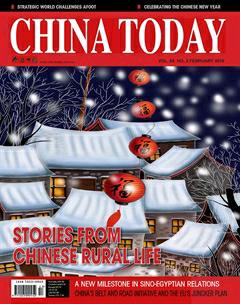Stockade Village of the Qiang Ethnic Minority
By staff reporter ZHOU LIN
Stockade Village of the Qiang Ethnic Minority
By staff reporter ZHOU LIN

Taoping Stockade Village features typical Qiang ethnic minority architecture.
S OME 18 0 kilom eters from Sichuan’s capital of Chengdu lies a 2,000-year-old stockade village that is home to the Qiang ethnic group. Taoping Village, located over the Zagunao River in Lixian County, with its intricately designed underground waterways, passageways, blockhouses and residences, is regarded as a living fossil of the Qiang architectural art.
The family of Tang Ying, a young tour guide at the China Youth International Travel Service, has been living in Taoping for generations. Twice weekly, Tang travels with groups of tourists between Chengdu and the famous national park Jiuzhaigou – Valley of Nine Fortified Villages. The trip takes them past her home village, where she spent her childhood, and which she introduces to the tourists.
The stone homes and blockhouses of the Taoping Stockade Village are built on steep mountain slopes. The village is designed according to the traditional Eight Trigrams: it has eight gates and 13 passageways inside the village, which lead to the central blockhouses. The passageways, with homes built above them, are deep and give a feeling of seclusion. They extend in all directions and form a maze in which a newcomer can easily get lost.
Upon entering the village, visitors will hear what sounds like a flowing stream, but won’t be able to find it. This is the biggest mystery in Taoping. The village’s main thoroughfares and residences are situated above underground waterways, from which people have easy access to water just by removing a cover. It is said that this water system was designed to help in firefighting and to cool the village in summer.
The blockhouses range in height from a few meters to tens of meters tall, and their shapes include quadrangles, hexagonals and octagonals. Some were constructed with earth, stone, chopped hemp fiber and wood, while others used clay and wood. It is said that the Qiang ethnic group made no architectural plans or measurements before starting construction, so their buildings featuresome sharp edges. This is a rare feature in old architecture.

The traditional wedding ceremony of Yang Wei and Zhang Yanju of the Qiang ethnic minority.
During the 2008 Wenchuan Earthquake, clusters of traditional Qiang buildings in Sichuan Province were destroyed – except for those in Taoping Village.
The most remarkable place in the village is the Yang Family Compound, a 1,000-year-old courtyard where the first village chief lived. It is the source of Taoping’s water: springs flow down the mountain to it, and water then gets distributed to all the homes. Covering 368 square meters, it is the village’s oldest and best-preserved home. To this day it still controls the village’s water supply.
Yang Dengfu, owner of the compound, is the 54th-generation descendant of the Yang clan. He likes to take tourists on tours of his residence. On the right side of his compound is a passage that leads to the underground waterway, from where one can also enter a dark room without a single window. There are four or five doors to his house, but only two are used. The others are traps for invading bandits.
Up a flight of wooden stairs is a blockhouse. Feeling the embrasures on its walls reminds people of times of war in China. They are a reminder of the hardships the Qiang suffered in the old days.
QIaNg arChITECTurE
The most remarkable place in the village is the Yang Family Compound, a 1,000-year old courtyard where the first village chief lived.
Life was hard even just a few decades ago. Tang Ying, the tour guide, said that when young, she wore hand-me-downs from her elder brothers. Villagers’ lives have improved since, as seen in the layout and decorations in every home.
A typical Qiang residence is usually three stories tall. Large hunks of cured meat hang beside the ground floor doorway. The second floor has a platform where pumpkins are piled high and clusters of corn cobs and peppers hang beneath the wooden loft. Pots of flowers dot the walls.
Most youngsters would rather earn a living as migrant workers than stay in the village, leaving elders to tend to small businesses or idle in the sunshine. The Qiang men’s traditional attire comprises blue gowns, sheepskin outer coats and cyan-colored coifs. Women wear blue and green gowns with lace trimming, embroidered aprons, ribbons and black headdresses.

A Qiang tot dressed in her traditional best.
The Qiang, whose history goes back 3,000 years, is one of the oldest ethnic groups in western China. Goat-inspired decorations can be seen all around the village. According to legend, the ancient Qiang survived mainly by herding goats, and the animal’s significance in the community’s social and economic life is clear from each household’s decor.
Spring and autumn bring the Qiang’s most solemn festivals. The Worshipping Mountain Festival and the Qiang New Year are both agricultural celebrations and religious traditions. They offer prayers in early spring and rejoice in reaping their rewards in autumn.
Whenever there are traditional festivals or sacrificial activities, Tang Ying and her fellow villagers get together to sing and perform their traditional Shalang Dance. Men in ethnic garments and women accessorized in exquisite embroideries and jewelry represent their villages in a songfest. This tradition, which has prevailed through time, developed the Qiang’s characteristic polyphonic singing.
“After years of chaos caused by wars and a nomadic lifestyle, the Qiang ethnic group loves life wholeheartedly and has cultivated a bold personality, evident in their wild dances and straight approach to talking and handling affairs,” Tang Ying said.

